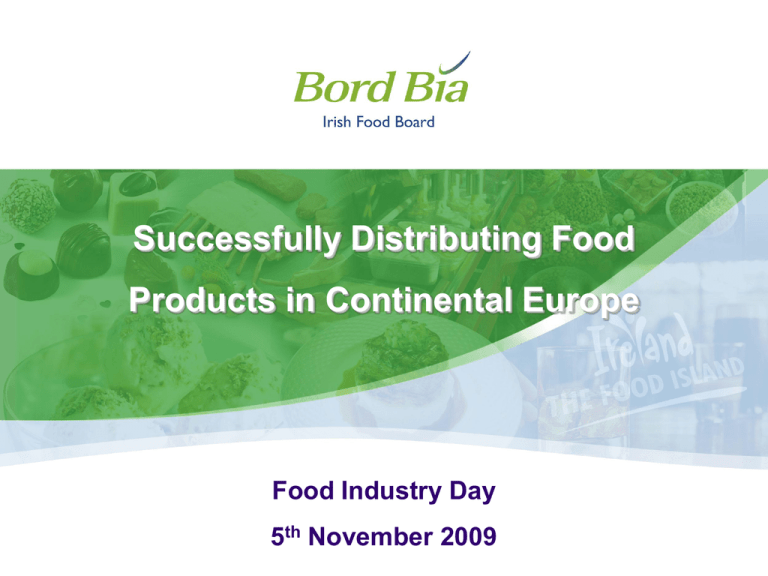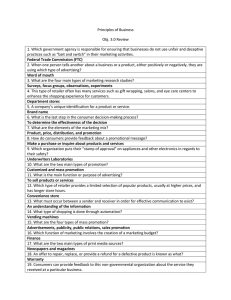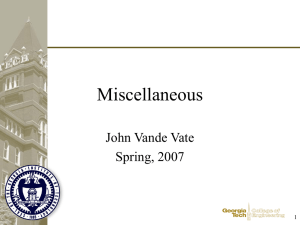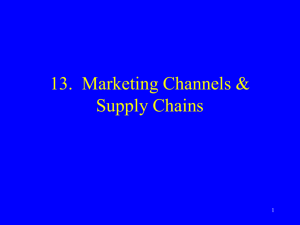Successfully Distributing Food Products in Continental Europe Food Industry Day 5
advertisement

Successfully Distributing Food Products in Continental Europe Food Industry Day 5th November 2009 The challenge of distribution • Remains major challenge for exporters on the Continent • Each market needs to be examined independently • No “one size fits all” solution • Need to be realistic about capabilities & resources • Exporters also face legal, language and cultural barriers • Need to be willing to adapt products, logistics etc Outline • Background & methodology • Summary of key findings • Review of case studies • Key learning's/Conclusions Background & Methodology Background to research • Main objectives: – Examine distribution systems of companies from similar background – Determine process used in deciding on distribution model – Summarise key learning’s from this process – Identify key criteria for Irish manufacturers Research methodology • Work undertaken by Green Seed • Case study approach – 13 in total – Mostly UK companies • French, Spanish, Swedish & Dutch markets • Mix of desk research & interviews • Undertaken during September/October Summary of key findings Rigorous market evaluation needed before considering distribution Initial analysis & introduction to market Determine USP’s versus competition Determine likely price competitiveness - Desk research & store visits - Assessment of distribution options - Identify unique points - Product adaptation required - Price checks etc Understand market entry requirements - Labelling, packaging & tax levels - Traceability, GMO issues etc. Establish key objectives - Branded vs. private label - Retail vs. Foodservice Draw up key criteria to determine most appropriate distribution system Key criteria to consider Acceptable timeframe to finalise distribution - Long term solution but time intensive - Quicker solution that can be adapted Importance of direct relationship with customers - Direct customer management - Handing over responsibility to 3rd party Logistics capability - Direct with service provider - Handover to importer/distributor Account management role - Local presence/language capabilities - Employing third party Delivery issues - Timed delivery vs. local warehouse - Meeting lead times & shelf life issues Competition - Domestic supply capability - Competitiveness of existing suppliers Distribution options considered • Different options examined in case studies include: – Direct/Direct via Logistics Service Provider (LSP) – Importer/Distributor – Joint venture /Acquisition of a local supplier – Setting up a local office Case studies highlight need for company/market specific approach Each option has positives/negatives Direct via LSP Importer/ Distributor Joint venture Local Office Dedicated local presence X X Local knowledge/sales force X Existing distribution network X X Importer takes ownership X X Direct customer contact X X Maintain control X X Takes time to set up X Cultural/language barriers X X Significant investment X X Reduced distribution costs X Lessons Learned • Must be flexible and willing to adapt products & approach • Time and financial investment required • Be ready before you present to the trade • Don’t assume everyone speaks your language • Distribution models can rarely be duplicated across several markets You only get one chance – it’s important to be right first time! Review of case studies France Chilled value added seafood supplier Company size Turnover: €11m Employees: 34 Product Range Shellfish and dip snacks & microwaveable shellfish starters Target market channels Retail & Foodservice (50:50) Leading retailers, convenience stores Branding Mix of branded and private label Pack formats Modified atmosphere packaging for retail Experience exporting to France Exporting since 2007 Mainly retail – mix of branded and private label Background to targeting French market • Why France? – Following market research, prioritised France, Spain, Germany and Holland • Already exporting to other markets? – Previously had business in Belgium – France is priority market for now • What research had they done? – Employed expertise in market to guide their approach – Undertaken desk research, store visits etc • Key issues in deciding on distribution model – New to exporting, therefore no logistics model – Relatively short product shelf life – Limited resources available for “on the ground” activities Distribution model chosen Importer/Distributor – Seafood Specialist • Manages both branded and private label accounts • Takes ownership of the goods when they arrive in France • Requires exclusive distribution of products in France • Manages sales and marketing of brands & private label development • Company delivers twice a week to depot • Company maintains contact with the trade – joint meetings Logistics Model Retailer depots Importer / Distributor Chilled added value seafood manufacturer Retailer depots Wholesalers Logistics provider based in UK Why was this model chosen? • Importer does considerable account management • Offers “on the ground” sales force • Covers both retail & foodservice sectors • Importer willing to handle both branded & private label • Good flexibility • Shelf life is maximised Plans for the future • Happy with growth in volumes • Believe current distribution model can handle more volume Potential issues • Costs involved when using local partner • Tied to one importer/distributor • Need to be sure importer keeps pushing their product The Netherlands Chilled & frozen ready meals manufacturer Company size Turnover: > €150m Employees: 1000 Product Range Chilled & frozen ethnic ready meals Target market channels Retail only Branding Mainly private label Pack formats Dutch market: sealed black bowl with sleeve Experience exporting to Netherlands Leading retailer employed firm to find potential suppliers Private label business commenced in 2006 22 Background to business development • Why the Netherlands? – Company shortlisted for private label business with leading retailer • Already exporting to other markets? – Limited volumes to the Netherlands and Belgium • What research had they done? – Once shortlisted research undertaken to find unique meal offering – Once chosen extensive product development • Key issues in deciding on distribution model – Exclusively supplying one retailer so direct route favoured – However, retailer requirement to supply products on CBL crates a major issue – Needed to find alternative Distribution model chosen Direct via co-packer appointed by customer • Unique & exclusive recipes for retailer under their private label brand • Export business is done with co-packer – Act as an additional depot for retailer – Send orders and receive invoices from the company (EDI) • Ready meals supplied to co-packer who repacks them into CBL crates • For chilled products, lead time is 24 hours, 6 days per week. Shelf life 10 days from production Logistics Model Orders via EDI Retailer shops Retailer Headquarter Retailer shops Retailer shops Orders per EDI Invoices Chilled & frozen ethnic meal manufacturer Retailer depots Invoices Orders via EDI Dutch CoPacker Retailer depots Retailer depots Retailer depots 25 Why was this model chosen? • Direct delivery into retailers 4 regional depots didn’t work due to demand to supply products in CBL crates – Non-fit with the UK production set-up and very high logistic costs • Conclusion: moving from delivery depot to ex-works price was the best option. • Using co-packer was both time and cost efficient option, preferred by retailer • Business Development Consultant acts as first point of contact • Deliver to one hub instead of four • Control over stock levels Plans for the future • Current system works well with no plans to change • Straight forward system Potential issues • Co-packer can put own products as priority • Requires more communication in relation to forecasts, waste etc • Less control over process as dependent on co-packer to maintain service levels Spain Dairy manufacturer Company size Turnover: €1.5bn Employees: 8,500 Product Range Full range of dairy products Target market channels Retail 85%, B2B 15% Branding Strong emphasis on branded products Pack formats No. of different format including individual packs for retail Experience exporting to Spain Exporting for 10 years with steady growth Initial focus was expatriates Exports worth €1.3m, cheese & spreads Background to business development • Why Spain? – Saw opportunity for brands given strong expatriate, tourist market • Already exporting to other markets? – Exporting to Germany, France, Holland and outside of Europe • What research had they done? – Minimal market knowledge so sought local expertise – Aware of competitive nature of market • Key issues in deciding on distribution model – Cautious approach - initially targeting the expatriate market – Need to obtain local expertise – Seeking cost effective distribution Distribution model chosen Appointed local importer/distributor • Local consultancy firm employed to shortlist potential importers/distributors • Entered exclusive agreement with a local distributor/importer • Distributor takes ownership of products • Has sales force & dedicated account manager for larger retailers • Company suppliers distributor once every 2/3 weeks • Have ex works agreement, which means distributor collects goods • Orders sent from distributor to company Logistics Model Retailer depots Ex-works Chilled dairy manufacturer Local distribution partner Sales reps / agents Retailer stores Sub distributors Regional wholesalers Why was this model chosen? • Offers good local knowledge • Capability to offer both regional & national distribution • Distributor takes goods directly from company in UK • Straightforward export process for company • Seen as cost and time effective entry strategy • No issue over holding stocks in the market Plans for the future • Current system has delivered steady growth • Works well at regional level but not as strong nationally • Recently appointed their own account manager to drive national roll out Potential issues • Need a dedicated on the ground presence to develop national business • Exclusive agreement restricts potential to work with other partners • Service levels down to distributor • Little contact with final customer Sweden Frozen ready meals Manufacturer Company size Turnover: €160m Employees: 500 Product Range Frozen ready meals Target market channels Retail 90%, Foodservice 10% Branding Mix of branded and private label Pack formats Dedicated retail and foodservice packs Experience exporting to Sweden Exporting to Sweden since 1999 Exports now exceed €10m Present in number of leading retailers Background to business development • Why Sweden? – Saw potential gap in the market that its products could fill • Already exporting to other markets? – 15 years experience exporting across Europe • What research had they done? – Use standard market entry “template” while allowing for specific requirements – Select leading retailer and “deep dive” – Adapt products as necessary to match local tastes – Process took 18 months • Key issues in deciding on distribution model – Recognised need for local expertise – Needed someone to handle and deliver goods – Wanted to maintain direct contact with customers Distribution model chosen Direct via intermediate warehouse + local expertise • Market is handled in collaboration with local consultancy firm • Third party used to store goods and handle deliveries • Company handles orders and invoicing • Logistical set up with retailers managed by local firm • Local consultancy firm is first point of contact for customers • Not using a “national” sales force Logistics Model Retailer depots Frozen and chilled ready meals manufacturer Local intermediate warehouse Retailer depots Foodservice partner/depots Others Local Consultancy Firm Why was this model chosen? • Offers company direct contact with customers • Able to use local expertise to act as “eyes and ears” • Local contact point for customers • Local intermediary handles storage and deliveries • Able to utilise full truck deliveries • Believe they cut costs by 12-25% plus the cost of running a local sales force Plans for the future • System working well and able to handle growth in volumes etc • Further extension of product range planned • Increasingly supplying other Nordic markets from Sweden Potential issues • High cost of keeping stock locally highlights need for accurate forecasting • Lack of sales force can make it difficult to secure full distribution • Doesn’t own the distribution network • Need to ensure local partner is dedicating sufficient time to products Key learning’s/Conclusions Key questions to consider • How well do I understand the market? • Will my product appeal to local consumers? • Can I be competitive, what are my USP’s? • Does my product meet commercial and legal requirements? • Which channels do I want to target? • What resources do I want to dedicate to exporting? • Knowledge/resources to handle exports directly or do I need a local player? • Do I require local expertise in assessing which distribution system to adopt? Conclusions • No “one size fits all” solution • Need to show ability to adapt products to local tastes • “Local” presence required but this can take many forms – Local expertise to assess market & identify potential partners – Local importer/distributor – Potential for joint ventures – Setting up local office Conclusions • Need to be realistic about capabilities & resources – Acceptable timeframe to finalise distribution – Importance of direct relationships – Logistics capabilities – Ability to handle account management role – Delivery lead times given product shelf life – Acceptable cost levels It will take time to finalise! Successfully Distributing Food Products in Continental Europe Food Industry Day 5th November 2009




